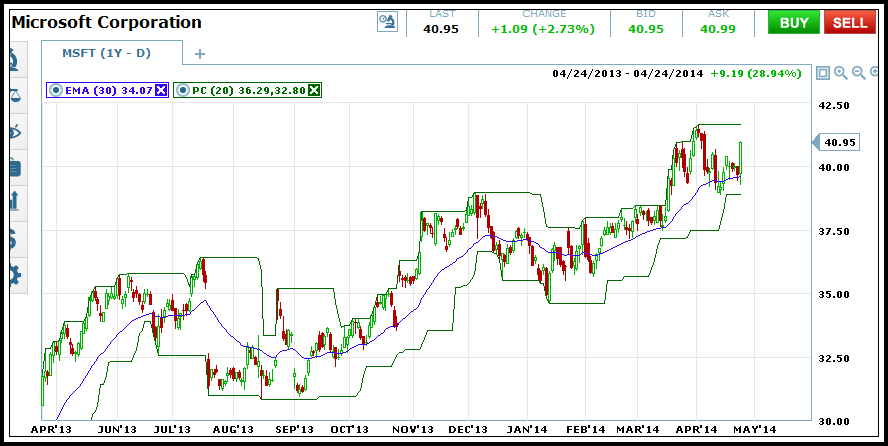New Binary Options Trader? Time for Channeling Prices To Reap Profits
Full Review of the Basic Price Channels Tool for Binary Options
Price channels are one of the most basic forms of technical analysis. In fact, price channels have been used as the foundation for many trading strategies and even for other indicators. The famous Keltner Channels and Donchian Channels (Review Soon!) are both based on basic channel theory. Price channels are lines drawn above and below the current asset price. Lines for basic channels are based on the highest price of X periods and the lowest price of X periods. The channels remain the same so long as a new high or low is not set and can be used as price targets, support, resistance and even as a gauge of volatility.
How To Use Price Channels For Binary Options
Price channels are easy to calculate which is why they are so popular as a basic tool. In the old days is was much easier to maintain current price channels on a hand drawn chart than it was to draw MACD, RSI, Stochastic or deviation bands. The basic formulation is simple. Take the highest price over the last X number of days and the lowest price and draw horizontal lines from each. Then average the high and low to get the center line. The channels can be drawn on any time frame of chart and the X period can be adjusted. The standard setting is for period of 20 days. A shorter period will make a tighter channel while a longer period will make a wider channel.
The basic price channel provides three main signals:
The first is the thrust. The thrust is whenever the price of the asset moves outside, or thrusts, the channel. This is an entry signal for a trade in the direction of the thrust. If the asset moves outside the channel to the upside then it is a signal to buy calls, if it breaks the channel to the downside it is signaling to buy puts. Expiry will depend on which time frame chart you are using.
The next type of signal is overbought/oversold. This is a coincident indication for trending markets. Once a thrust has been identified and a trend is in place traders can move down to a shorter time frame chart. In the case of an uptrend if the asset price moves below the lower channel line on the shorter term chart it can signal a potential reversal in the longer term. For example if on the daily charts you are trading a bullish thrust, you can move down to the hourly charts to look for an “oversold” signal.
The third signal is the confirmation of support and/or resistance. When the price channel is coincident with another indication of support such as a trend line or Fibonacci retracement it is stronger sign than when used alone.

Why Price Channels Might Suck
Price channels might suck because they are a lagging indicator. By the time an assets price has moved to the upper or lower channel boundary and then broken a good portion of the move has already occurred. This can be frustrating for traders who like to get into a trade as early as possible. It also might suck because by itself it is just a tool and does not take trend or other factors into consideration. Without additional analysis, indicators, strategy etc this tool will give off a lot of false signals that could result in unmanageable losses.
Why Price Channels doesn’t Suck
Price Channels might not suck for quite a few reasons but can be summed up in one word; adaptable. Price channels are very adaptable and can be used in a number of ways. First, they can be used in any time frame and even used in multiple time frame analysis. Second, when used with another trend following indicator to weed out false signals can be used to provide numerous short term entry points in a longer term trend. Third, the indicator is easy to understand and easy to manipulate. The basic Price Channel simply uses the high and low of X periods to form a channel. Changing the period can be used tighten or loosen the channels as your strategy, technique and analysis dictate.
My Last Words On Price Channels
Price channels are a fantastic tool for binary options traders and perfect way for new traders to get into technical analysis. The tool itself is super easy to understand, super easy to follow and super easy to adjust even though it doesn’t really need it. By itself the tool can provide a lot of false signals so it is necessary to use other analysis before entering any trades. Other than that it is pretty straightforward to use. As a strategy itself I would suggest to use the multiple time frame approach at least, use the longer term to set up the trend and then the shorter term to enter trades.